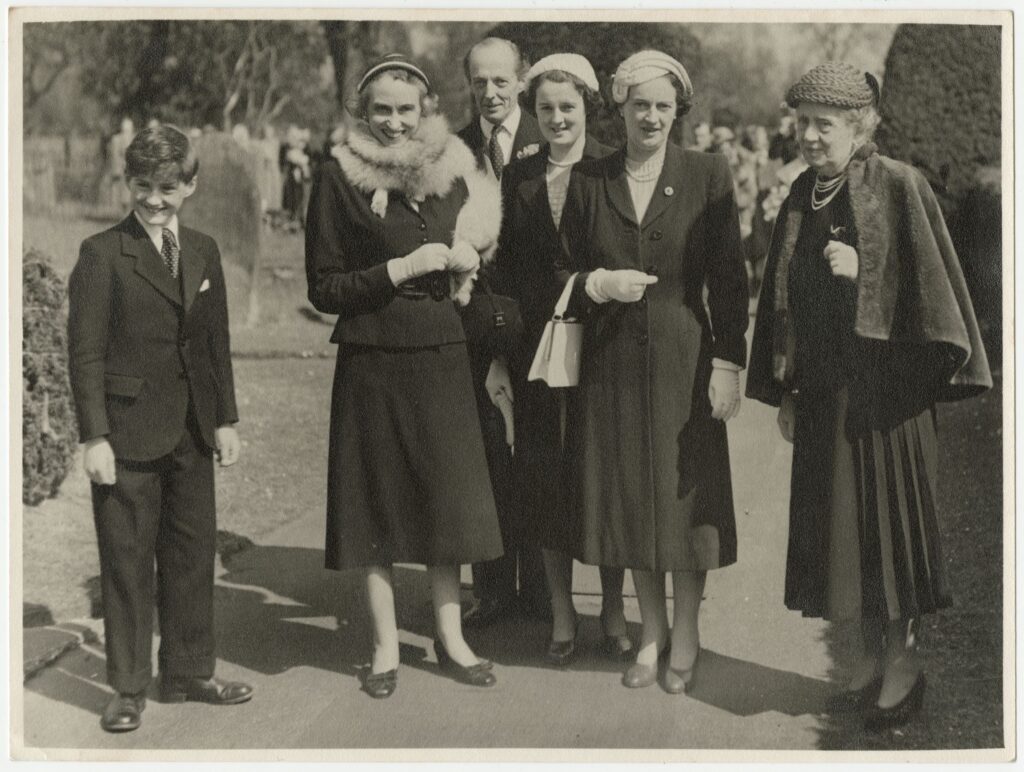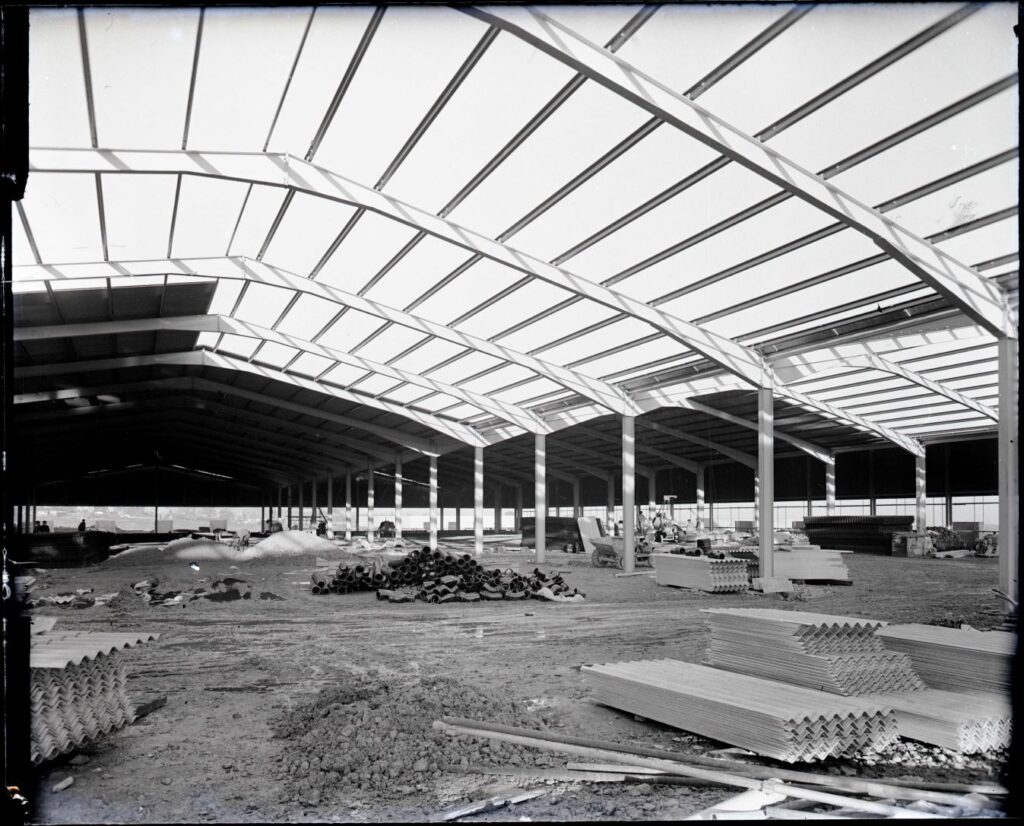This blog has been researched and written by Shelley Lanser, one of the volunteers on our maternity care project. Project volunteers are researching maternity care in Northumberland with particular focus on Castle Hills Maternity Home, Berwick, and Mona Taylor Maternity Home, Stannington. In 1943, Lady Ridley gave an address at the opening of Mona Taylor Maternity Home. She was also heavily involved in the Newcastle Babies Hospital for many years and organised the evacuation of the Hospital to her home, Blagdon Hall, during World War Two.

Ursula Viscountess Ridley was a woman who cared about the poor, about women and – above all – about children.1 This is the first of several blog posts about Lady Ridley, wife of the third Viscount Ridley.
Ursula’s father was Sir Edwin Lutyens (1869-1944)2, the famous architect. Edwin Lutyens is described as a shy and inarticulate man who hid his shyness with non-stop quips and jokes.3 Ned, as he was familiarly called, was born in 1869, the tenth child and the ninth boy in a family of ten boys and three girls.4 His father, Charles Lutyens (1829-1915)5, was a gentleman, a member of a military family,6 also an eccentric bohemian7. As well as having served in the army, Charles was a painter whose works were exhibited in the Royal Academy. In his later years, Charles began to go blind and his income from the paintings dropped off, leading him to make unusual economies in the household. Ned was affected by the change in his family’s lifestyle and worried all his life about money.8 Ned’s mother, Margaret “Mary” Gallwey Lutyens (1832/3-1906)9 came from Ireland; her father was a General in the Royal Irish Constabulary.10
Ned took his first commission when he was barely 20, for a nine-bedroom house.11 In that same year he met Gertrude Jekyll, the noted garden designer, with whom he would work closely in future years.12 She was to heavily influence his career. She not only created gardens for the houses he designed, but provided many social contacts with people who had the wealth to employ him. One of these contacts was Edward Hudson, founder of Country Life magazine. Hudson did many double-page spreads of photographs in his magazine showing the Lutyens-Jekyll houses and gardens, which in turn found them both more commissions.13 Hudson became Ursula’s godfather.14
Lutyens went on to become an extremely prolific designer, accepting in the neighbourhood of 800 commissions during his career including an astonishing range.15 Some of his most famous designs include Queen Mary’s Doll House;16 war memorials such as the Cenotaph17 in Whitehall and the Thiepval Memorial to the Missing at the Somme, in France;18 the British Embassy in Washington, D.C.;19 Arts and Crafts houses, including Munstead Woods,20 built for Gertrude Jekyll; several castles, including Lindisfarne Castle on Holy Island (commissioned by Edward Hudson);21 and the Viceroy’s House in New Delhi, now called Rashtrapai Bhavan, residence of the President of India.22 Lutyens was knighted in 1918.23
Ursula Lutyen’s mother was Lady Emily Bulwer-Lytton (1874-1964), daughter of Edward Bulwer-Lytton, (1831-1891)24, 2nd Baron of Lytton (later the 1st Earl of Lytton), who was Viceroy of India between 1876 and 1880. Unfortunately, he was never very good at managing his finances and when he died in 1891, while serving as Ambassador to France, it was found that a dishonest “man of affairs” had left the Earl’s widow badly off.25 Emily’s mother was Edith Villiers (1841-1936)26, of the aristocratic Villiers family.27 After her husband died, Countess Lytton became a lady-in-waiting to Queen Victoria, in order to fund the education of her sons at Eton and Cambridge.28 Emily is described as having a strong personality and a bit of a temper;29 she would fight to get what she wanted.30 Though initially Emily’s mother was against their engagement,31 she was won over eventually. The couple were married in August, 1897.32
The Lutyens’ marriage was strained by the fact that Ned and Emily had little in common other than being intensely romantic. She loved the countryand the seaside; Ned cared for neither unless he had work there.33 She was interested in women’s rights;34 he thought women belonged at home.35 The sharing and discussing of books was important to Emily36 but books meant little to Ned.37 Emily grieved that they didn’t share any interests.38 A couple of years after the birth of her youngest child, she became deeply involved with Theosophy,39 a new religion at the time, teaching about reincarnation and mixing western and eastern beliefs. Theosophy was popular among a number of Edwin Lutyen’s wealthy clients and all of his children, with the exception of Ursula, were followers at some point.40 Emily become vegetarian shortly after they married.41 They had few common friends.42 Ned dreamed of domestic bliss in a white house they never built;43 Emily had no interest in domesticity or in running a house with servants.44 They spent large amounts of time apart: once Ned won the commission for the Viceroy’s Palace, he spent winters in New Delhi and summers at home.45 However, Emily routinely took the children to the seaside for several months in summer. (During one holiday at the seaside, she and a friend would read fairy stories aloud to prostitutes in hospital with venereal disease). 46 Even their weekends were largely separate. Emily had insufficient confidence or motivation to entertain Ned’s potential clients and disliked attending the Saturday to Monday invitations important to his business. Over time it was understood that he was available on his own,47 and his wit and humour made him a popular house guest.48 When apart they wrote letters to each other almost daily, sometimes twice a day, leaving over 5,000 letters written during their forty-seven-plus years of marriage.49
It is thought Ned may have had an affair with Lady Victoria Sackville (mother of Vita Sackville-West), a married woman.50 They were certainly good friends, calling one another MacSack and McNed.51 This relationship began a couple of years after Emily wrote Ned that she would no longer have sexual relations with him.52 After Ned’s death, while working to organise her father’s letters, Ursula expressed the hope that her father had found some physical fulfilment with Lady Sackville.53 In one of Emily’s letters to Ned she encourages him to find another woman; his reply was that he couldn’t possibly afford to keep a second woman in the manner which she would deserve.54 Emily may have had an affair with Krishnamurti, a much younger Indian man who at one point was considered a messiah among the Theosophists.55 However, he was said to have a horror of sex and, while he returned her affection,56 they both worked to have a “higher love.”57 Whether or not there were affairs, Ned and Emily grew much closer in their later years, particularly in the last decade or so of Ned’s life when his commissions were not as numerous and Emily had lost interest in Theosophy.58
Ursula Lutyens was born into this family on the 31st of October 190459 in London, the middle child of five. She had an older sister, Barbara “Barbie” (1898-1981), an older brother, Robert (1901-1972), and two younger sisters: (Agnes) Elizabeth (1906-1983) and (Edith Penelope) Mary Lutyens (1908-1999).60 Barbie and Ursula were close. Not much is said about her relationship with her brother, but that with her younger siblings was marked by squabbling and jealousy of one another. Ursula was widely acknowledged as her father’s favourite, possibly because he found her the least taxing to be with.61 She was described as “charming” and “talented” as a child.62 Also (aged 4) the prettiest of her siblings, and an unredeemable flirt. Her siblings thought her a show-off. 63
The whole family had a deep appreciation for the Nannie. The anniversary of Sleath’s arrival was celebrated each year; they called it her “Nanniversary.”Alice Louisa Sleath was 24 years old when she joined them in 1898; she remained with the family until her death in 1938, aged 64.64 Ned, like most men of the day, left child rearing to his wife. Emily, in the usual aristocratic way, left the care of the children to the Nannie.65 Nannie Sleath was the most important person to the children.66
Sources:
1, Sterk, Sidney, “The Woman Who Cared”, Newcastle Journal, December 29, 1967, p6 https://www.britishnewspaperarchive.co.uk/viewer/bl/0002240/19671229/064/0006.
2. Stamp, Gavin, “Lutyens, Sir Edwin Landseer (1869-1944), in Oxford Dictionary of National Biography, Vol. 34, Ed. HCG Matthew and Brian Harrison, Oxford, Oxford University Press, 2004, 817-825.
3. Lutyens, Mary, Edwin Lutyens by his daughter (London: John Murray, 1985), p ix.
4. Lutyens, p 1.
5. Stamp, p 817.
6. Ridley, Jane. The Architect and His Wife – A Life of Edwin Lutyens (London, Chatto & Windus, 2002) 7-8.
7. Lutyens, p 22.
8. Stamp, p 817.
9. Ridley, p 9.
10. Lutyens, p 22.
11. Lutyens, p 24.
12. Lutyens, pp 27-28.
13. Lutyens, p 65.
14. Lutyens Trust America, “The Life and Legacy of Sir Edwin Lutyens (1869-1944)”, Martin Lutyens, Robin Prater and Jane Ridley, May 10, 2020, Webinar, 3.47 to 3.58, https://www.youtube.com/watch?v=ARILhNz-OJg&t=2489s.
15. Lutyens Trust America, 38:46 to 40:30.
16. Lutyens Trust America, 15:05 to 17:38.
17. Lutyens Trust America, 17:33 to 19:24.
18. Lutyens Trust America, 41:15 to 41:27.
19. Lutyens Trust America, 6:50 to 8:20.
20. Lutyens Trust America, 32:15 to 34:20.
21. Lutyens Trust America, 13:01 to 14:50.
22. Lutyens, p 159.
23. Stamp, p 818.
24. Lutyens, p 28.
25. Stamp, p 818.
26. “Link of 95 Years Broken by Twin’s Death,” Nottingham Journal, September 19, 1936, p 4. https://www.britishnewspaperarchive.co.uk/viewer/bl/0001898/19360919/090/0004
27. Lutyens, p28.
28. Lutyens, p 49.
29. Lutyens, p 39.
30. Lutyens, p 41.
31. Lutyens, p 56.
32. Lutyens, p 60.
33. Percy, Clayre and Jane Ridley, The Letters of Edwin Lutyens To his wife, Lady Emily, (London:Collins, 1985), p 149.
34. Ridley, pp 148, 307.
35. Lutyens, p 77.
36. Lutyens, p 11.
37. Lutyens, p 77.
38. Lutyens, p 89.
39. Ridley, p 321.
40. Ridley, p 122.
41. Lutyens, p 131.
42. Ridley, pp 110-111.
43. Lutyens, p 59.
44. Percy, p 296.
45. Ridley, 168.
46. Lutyens, p 60.
47. Lutyens, p 191.
48. Ridley, p xi.
49. Lutyens, pp 196.
50. Lutyens, p 155.
51. Ridley, p 247.
52. Lutyens, p 199.
53. Lutyens, p 213.
54. Ridley, p 191.
55. Lutyens, p 122.
56. Lutyens, p 200.
57. Lutyens, p 249.
58. Lutyens, p 61.
59. Stamp, 823.
60. Ridley, p 170.
62. Lutyens, p 148.
63. Ridley, p 170.
64. England, General Register Office, PDF copy of an entry of death, for Alice Louisa Sleath, died 4 Feb. and registered 5 Feb. 1938; a copy of an entry in the certified copy of a register of births in the registration district of St. Marylebone, County of London.
65. Ridley, p 243.
66. Ridley, p 170.









